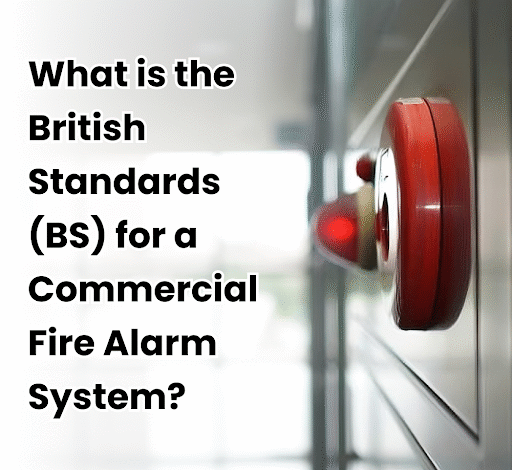What is the British Standards (BS) for a Commercial Fire Alarm System?

The British Standard fire alarm system requirement, which ensures that every commercial premises is adequately protected, is one of the cornerstones of fire safety in the country. Businesses can no longer afford to take fire safety lightly.
This is what BS 5839-1 framework deals with.
What is the Role of BS 5839-1 for UK Fire Safety?
The term BS 5839-1 might sound technical, but in practice, it is the UK’s most important reference point for commercial fire alarm regulations.
Updated most recently in 2025, this standard sets out the principles for designing, installing, commissioning, and maintaining fire alarm systems in non-domestic premises.
The statement that fire detection and alarm systems BS 5839 are the backbone of any workplace is not hyperbole. Without it, businesses run the risk of fines, shutdowns, or worse, lives being endangered.
For this reason, British businesses are encouraged to view BS 5839-1:2025 compliance as a top priority rather than merely a box-checking activity. Partnering with a trusted Fire Safety risk assessment service can help ensure that compliance is both thorough and practical.
Why Businesses Must Care About Compliance
Fires in commercial buildings are not rare incidents. From offices to warehouses, retail units to healthcare facilities, every type of premises carries risks.
Prevention and quick detection are the cornerstones of the commercial fire alarm regulations UK, and compliance with it is a legal requirement.
For a business, fire risk assessment is about much more than obeying the law. It also reassures employees, visitors, and customers that the organisation values safety. Having a British Standard fire alarm system in place demonstrates due diligence and a culture of responsibility.
What BS 5839-1 Covers
The standard itself is vast and detailed, but at its core, it defines how to approach fire alarm system standards UK across the whole lifecycle of an alarm system. That includes the design stage, the installation process, the commissioning checks, and the long-term upkeep.
In essence, this means that businesses are unable to selectively choose certain aspects of it, while declining others. Everything from detector placement to system testing comes under its scope. This is why the standard is often described as the backbone of fire alarm installation standards UK.
Design Requirements Under BS 5839-1
The BS 5839-1 design requirements are where mistakes can have lasting consequences. A poorly designed system may look fine on paper but fail in a real emergency.
The standard demands that designers assess the specific fire risks of a building, including its layout, occupancy, and potential hazards.
For example, a care home will have very different needs compared to a large office complex. This tailored approach is what makes fire detection and alarm systems BS 5839 reliable in practice.
To meet the BS 5839-1:2025 compliance benchmark, businesses must ensure that their systems are designed by competent professionals who can interpret the detailed guidelines and apply them correctly.
Installation Guidelines for Commercial Premises
Once the system is designed, the next challenge is the actual build. Proper BS 5839-1 installation guidelines ensure that alarms, detectors, call points, and panels are placed in the right positions, with minimal chance of failure.
This part of the process is where many businesses stumble, as shortcuts during installation can later lead to catastrophic failures. By following fire alarm installation standards UK, companies can safeguard their investment and avoid non-compliance issues during inspections.
A system that ticks the boxes at installation will be easier to commission and maintain. In contrast, poor workmanship at this stage will undermine the whole compliance effort.
The Commissioning Process Explained
No system is complete without rigorous testing. The BS 5839-1 commissioning process ensures that the fire alarm system works exactly as intended. It involves testing every component, verifying connections, and confirming that alarms trigger as designed.
This stage is important as it brings design and practical operation together. A building owner might believe their system is compliant, but until it passes through the BS 5839-1 commissioning process, there is no guarantee of safety.
Commissioning also provides the paperwork needed to demonstrate fire alarm system compliance UK. For regulators, insurers, and local authorities, this is evidence that the building meets the required standards set by the regulators.
Maintenance Standards That Keep Systems Alive
Even the best system will degrade over time. That’s why fire alarm maintenance standards UK are written directly into BS 5839-1. They set out how often a system must be tested, how faults should be addressed, and when upgrades are necessary.
A frequent cause of businesses getting in trouble with the law is when they neglect upkeep. A neglected system is a silent hazard, it looks present but fails to protect.
Following fire alarm maintenance standards UK not only prevents technical issues but also proves ongoing compliance.
Routine maintenance also ties into insurance requirements. Many insurers will not pay out after a fire if the building owner cannot demonstrate adherence to BS 5839-1:2025 compliance.
How BS 5839-1 Links to UK Law
The fire alarm system standards UK are not isolated from wider legislation. They link directly to the comprehensive fire safety regulations of 2005, and the Fire Safety Regulations as well as the Building Safety Act from the year 2022.
These legal frameworks place the responsibility of ensuring compliance squarely on those who own the buildings, and the managers of businesses operating inside buildings.
When regulators inspect a building, one of the first things they check is whether the fire alarm system follows BS 5839-1 design requirements and has been through the proper BS 5839-1 commissioning process.
Failing these checks doesn’t just risk fines, it could also mean prosecution. That’s why the UK government stresses the importance of aligning with fire alarm installation standards UK and maintaining systems throughout their lifecycle.
The Importance of Competent Professionals
A major focus of the BS 5839-1 installation guidelines is competence. The standard itself doesn’t just talk about systems; it also highlights the role of the people who work on them.
Third-party certification, such as the BAFE SP203-1 scheme, is often used to prove that contractors meet the fire alarm installation standards UK. For building owners, hiring certified professionals provides peace of mind that compliance is being taken seriously.
Working with an experienced UK Fire Risk surveyor ensures that every stage from design and installation to commissioning and maintenance meets the strict BS 5839-1 requirements.
Common Pitfalls in Fire Alarm Compliance
Even with clear standards in place, many UK businesses still make mistakes. Some cut corners during installation, ignoring the BS 5839-1 installation guidelines in favour of saving money.
Others fail to keep up with fire alarm maintenance standards UK, assuming that once a system is fitted, the job is done.
The neglect to bring outdated systems up-to-speed with current times is another prevalent issue. The 2025 revision of BS 5839-1 brought in new expectations, and ignoring these changes places a building at risk. That is why continuous mindfulness of BS 5839-1:2025 compliance is so important for facility managers.
The 2025 Update and What It Means
The release of BS 5839-1:2025 is a significant milestone. It incorporates learning from past incidents, new threats, and new technology. The fire detection and alarm systems BS 5839 has changed throughout time to keep up with the demands of contemporary structures.
For example, the new edition places even greater emphasis on competence, clarity in design documentation, and responsibilities for building owners. These adjustments mean that achieving fire alarm system compliance UK now demands closer collaboration between designers, installers, and managers.
By updating to the latest edition, businesses show regulators that they are serious about following the commercial fire alarm regulations UK. In contrast, sticking with outdated practices may be viewed as negligence.
How Inspections Are Carried Out
Local authorities and fire services regularly check whether buildings are following fire alarm system standards UK. These inspections often focus on documentation, testing logs, and physical condition of systems.
If inspectors find that the BS 5839-1 commissioning process was skipped or not properly documented, penalties are likely incoming.
Equally, if fire alarm maintenance standards UK are ignored, enforcement notices can be issued.
For businesses, the lesson is clear: inspections are not just about passing a test. They are about proving a culture of safety and commitment to ensuring fire safety in the UK.
The Cost of Non-Compliance
It is tempting for some businesses to view compliance as expensive. Yet, the cost of non-compliance is far greater. Fines, prosecutions, reputational damage, and even imprisonment for responsible persons are real possibilities under UK law.
A faulty system that doesn’t meet BS 5839-1 design requirements or fails under inspection can lead to insurance claims being rejected. That leaves businesses facing financial ruin.
Also, being in line with fire alarm installation standards UK ensures that both lives and livelihoods are preserved.
Fire Alarms as Part of Wider Safety Strategy
Fire alarms are not a one-all solution. The fire alarm system standards UK tie into emergency lighting, evacuation procedures, and staff training. Together, these measures create a complete safety net.
The BS 5839-1 installation guidelines remind us that even the best technology cannot save lives if it is not integrated into a building’s evacuation plan. Regular drills, clear signage, and ongoing staff awareness are all part of genuine fire alarm system compliance UK.
When businesses have well-defined plans and fire alarms, they can handle inspections with self-assuredness. They also give staff and customers peace of mind that the premises meet the strictest commercial fire alarm regulations UK.
Technology and the Future of Fire Alarm Standards
Technology never stands still. Future fire detection and alarm systems BS 5839 will probably incorporate AI-driven risk monitoring, smart building systems, and sophisticated ways of communication.
The 2025 update has already paved the way for such changes, but further revisions will inevitably follow. Businesses that embrace innovation while staying grounded in fire alarm maintenance standards UK will be best placed to adapt.
This future-facing approach ensures that compliance is not only about meeting today’s benchmarks but also preparing for tomorrow’s. The British Standard fire alarm system has, after all, constantly changed and adapted with the changing days.
The Role of Training and Awareness
If users are not adequately trained, even the most sophisticated technologies can fail. That’s why the BS 5839-1 commissioning process often involves handing over detailed information and guidance to the building’s responsible persons.
Training ensures that staff can recognise faults, respond to alarms correctly, and understand the basics of fire alarm maintenance standards UK. It also reinforces a safety-first culture, which regulators look for during inspections.
Without training, businesses may comply on paper but fail in practice. With it, they get to ensure BS 5839-1:2025 compliance in earnest.
The Bigger Picture of Responsibility
At the heart of all fire alarm system standards UK lies responsibility. The law requires that every non-domestic premises in the UK has a “responsible person” who ensures fire safety measures are in place.
This role is more than a title. It means making sure that BS 5839-1 design requirements are considered during planning, that the BS 5839-1 installation guidelines are followed by contractors, and that the BS 5839-1 commissioning process is properly documented.
It also means arranging regular testing and maintenance in line with fire alarm maintenance standards UK.
In short, the responsible person is the one who must tie every thread of compliance together to prove alignment with commercial fire alarm regulations UK.
Why Compliance Protects More Than Just People
While the first priority of a British Standard fire alarm system is to protect lives, it also safeguards assets, continuity, and reputation. Reputation is all-important in today’s UK business environment. One fire, or even one failed inspection, can undo years of effort.
By demonstrating full fire alarm system compliance UK, companies send a strong message to clients, partners, and regulators: safety is non-negotiable.
Additionally, they solidify an ethos of preparedness by integrating the fire detection and alarm systems BS 5839 framework into day-to-day operations.
Conclusion
The BS 5839-1 standard aids British businesses managing their fire alarm systems, at every stage.
Aligning with BS 5839-1:2025 compliance ensures that every British Standard fire alarm system in the UK does what it is meant to do, save lives, protect assets, and uphold responsibility.



